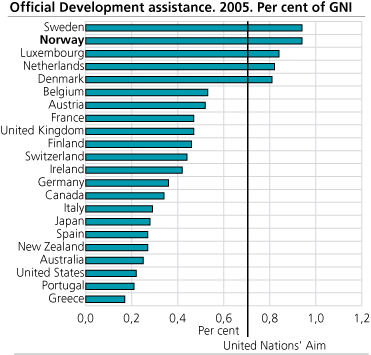Content
Published:
This is an archived release.
Sharp increase in development aid in 2005
Preliminary figures from the OECD show that official development assistance (ODA) from OECD countries increased by 32 per cent from 2004, corrected for price and exchange rate movements. For the OECD as a whole, this represents 0.33 per cent of member countries' total Gross National Income (GNI)
The level of development aid is usually measured as a percentage of gross national income (GNI) and is often used to compare countries’ expenditure on foreign aid. In 1970, the UN resolved that development aid should account for 0.7 of GNI. Norway, Sweden and Denmark achieved this goal relatively quickly in the 1970s. In 2005, only the Scandinavian countries, the Netherlands and Luxembourg met the goal.
0.33 per cent of GNI
For the OECD as a whole, the percentage of GNI was 0.33 in 2005, compared with 0.26 per cent in 2004. Measured in US dollar, the OECD countries increased the development aid by 27.4 billion. The increase was 32.0 per cent in real terms, corrected for price and exchange rate movements.
Debt relief grants more than tripled from 2004 to 2005 and amounted to USD 22.7 billion in 2005. Without debt relief grants the development aid from the OECD increased by 9.7 per cent in real terms, corrected for price and exchange rate movements.
US largest contributor
With USD 27.6 billion, the US was the largest contributor of all OECD countries in 2005, as in the previous four years, while Japan contributed the most the eight years before that. The US increased its development aid by 36.5 per cent in real terms in 2005. US expenditure on development aid was 0.22 per cent of GNI in 2005.
Norway and Sweden number one among OECD countries
Norway’s development aid was 0.94 per cent of GNI in 2005, while the percentage in 2004 was 0.87. The expenditure on development aid increased by USD 0.6 billion to 2.8 billion in 2005. The increase was 13.5 per cent in real terms, corrected for price and exchange rate movements.
|
Official development assistance. 2004-2005. Percentage change
2004-2005 |
| Million US dollar |
Real per cent
change1 |
Real per cent change1.
Without debt relief grants |
|||||||||||||||||||||||||||||||||||||
|---|---|---|---|---|---|---|---|---|---|---|---|---|---|---|---|---|---|---|---|---|---|---|---|---|---|---|---|---|---|---|---|---|---|---|---|---|---|---|---|
| 2004 | 2005* |
Dept relief
grants in 2005* |
|||||||||||||||||||||||||||||||||||||
| Norway | 2 199 | 2 786 | 2 | 13.5 | 14.0 | ||||||||||||||||||||||||||||||||||
| Denmark | 2 037 | 2 109 | 0 | 1.9 | 1.9 | ||||||||||||||||||||||||||||||||||
| Sweden | 2 722 | 3 362 | 53 | 24.1 | 23.3 | ||||||||||||||||||||||||||||||||||
| Canada | 2 599 | 3 756 | 455 | 31.2 | 18.7 | ||||||||||||||||||||||||||||||||||
| France | 8 473 | 10 026 | 3 212 | 16.8 | -0.7 | ||||||||||||||||||||||||||||||||||
| Italy | 2 462 | 5 091 | 1 670 | 101.4 | 42.0 | ||||||||||||||||||||||||||||||||||
| Japan | 8 922 | 13 147 | 3 553 | 51.7 | 12.7 | ||||||||||||||||||||||||||||||||||
| Netherlands | 4 204 | 5 115 | 324 | 19.8 | 18.3 | ||||||||||||||||||||||||||||||||||
| Germany | 7 534 | 10 082 | 3 441 | 32.9 | -5.5 | ||||||||||||||||||||||||||||||||||
| United Kingdom | 7 883 | 10 767 | 3 525 | 35.0 | 0.9 | ||||||||||||||||||||||||||||||||||
| United States | 19 705 | 27 622 | 4 078 | 36.5 | 17.0 | ||||||||||||||||||||||||||||||||||
| Others | 10 671 | 12 914 | 2 356 | - | - | ||||||||||||||||||||||||||||||||||
| Total DAC | 79 410 | 106 777 | 22 669 | 32.0 | 9.7 | ||||||||||||||||||||||||||||||||||
| 1 | Taking account of both inflation and exchange rate movements. |
For more information can be found on:
Tables:
Contact
-
Statistics Norway's Information Centre
E-mail: informasjon@ssb.no
tel.: (+47) 21 09 46 42

